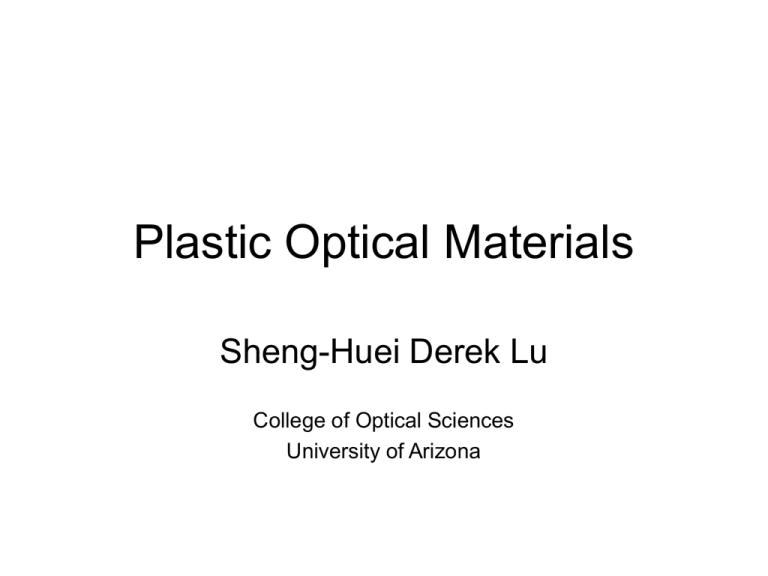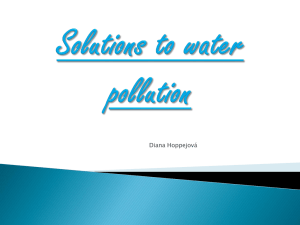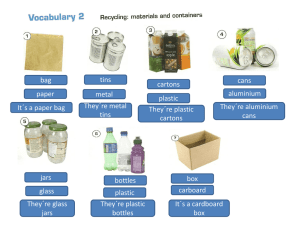Plastic Optical Materials - The University of Arizona College of
advertisement

Plastic Optical Materials Sheng-Huei Derek Lu College of Optical Sciences University of Arizona Apple iPhone 4 Camera Lens • Apple iPhone 4 Camera Specs: 5.0 Mpixels (2592 x 1936) 3.85 mm lens focal length f/2.8 lens aperture • Equivalent 35mm film camera 30 mm f/22 image is 2592x1936 pixels Cost isSample Everything!! (5.0 MP, 4.02:3) • Don't throw away your FourThird, APS-C or full frame SLR iPhone 4 Camera Module • Glass cell phone lenses cost $20-$40 in the market. • Plastic cost: $3.55 only • Manufacturer: Largan Precision Co., LTD, Taiwan Product#: 9457F Composition:4 Plastic Elements • Very high production volumes Injection Molding: 8-Holes Method 8 cavities at the same time Monthly volume = 207,306 parts Outlines • • • • Plastic optical material application Advantages Disadvantages Issues: Structural Stability Thermal Stability Moisture Absorption Injection Molding • Wavefont error budget • Reference What are optical elements made of plastic? • • • • • Cellphone/ NB/ Car/ Camera Lens Bar code scanners in CD players Prisms LED collimator Diffractive Optical Elements Main Advantages • • • • • Cost Production volume Weight reduction Aspheric and diffractive surfaces Integral features – can have mounting features or multifunction parts Disadvantages • Lower service temperature than glass - max service 80-130 ºC • Low structural stability - soft, larger deflection while applying force, lower resonant frequency than glass • Poor thermal properties – high dn/dT, high CTE • Moisture Absorption • Limited material selection Material Properties of Plastic Optical Element Plastic Element Structural Stability • ρ = 1 g/cm3, E = 3 Gpa (glass: ρ=2.5 g/cm3, E=80 Gpa) • Resonant frequency k m EI E bh3 k 3 3 ; l l 12 m bhl h 2 3l 3 E • Plastic with 1/3 resonant frequency than glass • Deflection per thickness E • Plastic with 10 times deflection than glass Plastic Element Thermal Stability • dn/dT = -8.5 ppm/ºC, CTE = 72 ppm/ºC, λ = 0.21 W/mK (glass: dn/dT = 1.86 ppm/ºC, CTE = 7 ppm/ºC, λ = 1 W/mK) • Defocus due to one degree change • β = 89 ppm/ºC for plastic, β = 3.28 ppm/ºC for glass • Linear thermal distortion of a constant heat flux Φ T L T ; L0 • Plastic with 50 times thermal deflection than glass Moisture Absorption • Water absorption: change of volume, change of refractive index - The coefficient of moisture expansion (CME) for PMMA is about 0.5% The change of refractive index for PMMA is about 900 ppm • Cycloolefin Polymer (COP) and Cycloolefin Copolymer (COC) are known as low moisture absorption. Injection Molding • Surface Imperfections - Melt temperature is too high to cause gas evolution: bubbles - Pressure is too low to cause incomplete filling of mold. • Shrinkage - If the part thickness is too thin, part will shrink while cooling. - Applying holding pressure is maintained to compensate for material shrinkage Tolerance Analysis: wavefont error budget for the plastic optical component 1 mold costs $200,000! Reference • Selected plastic optical material characteristics are listed in my tutorial: “Tutorial for Plastic Optical Materials” • Great reference book: Stefan Bȁumer etc. “Hand Book of Plastic Optics”, 2005 WILEY • Formulas: Prof. Burge, Opti 521/421 class note







